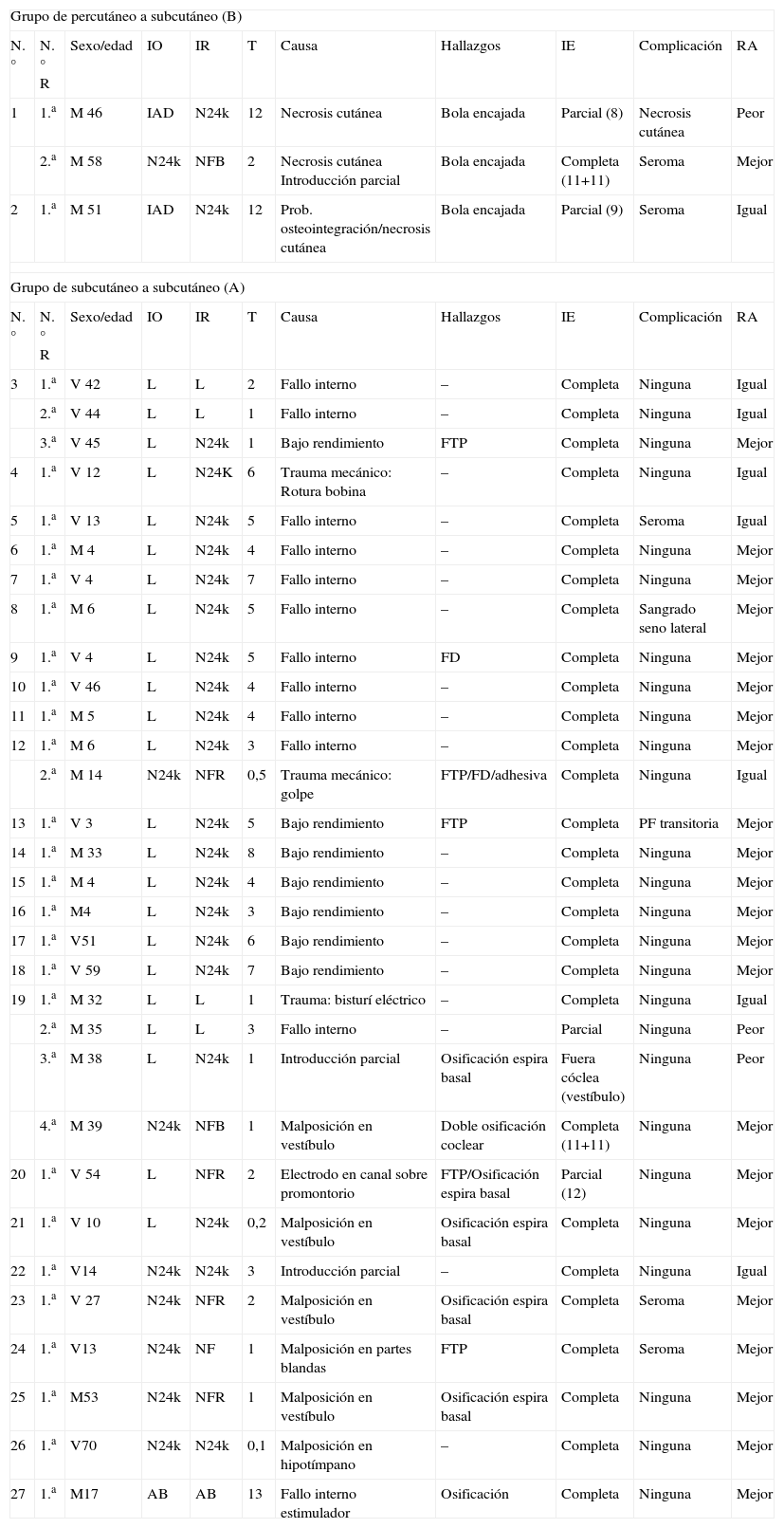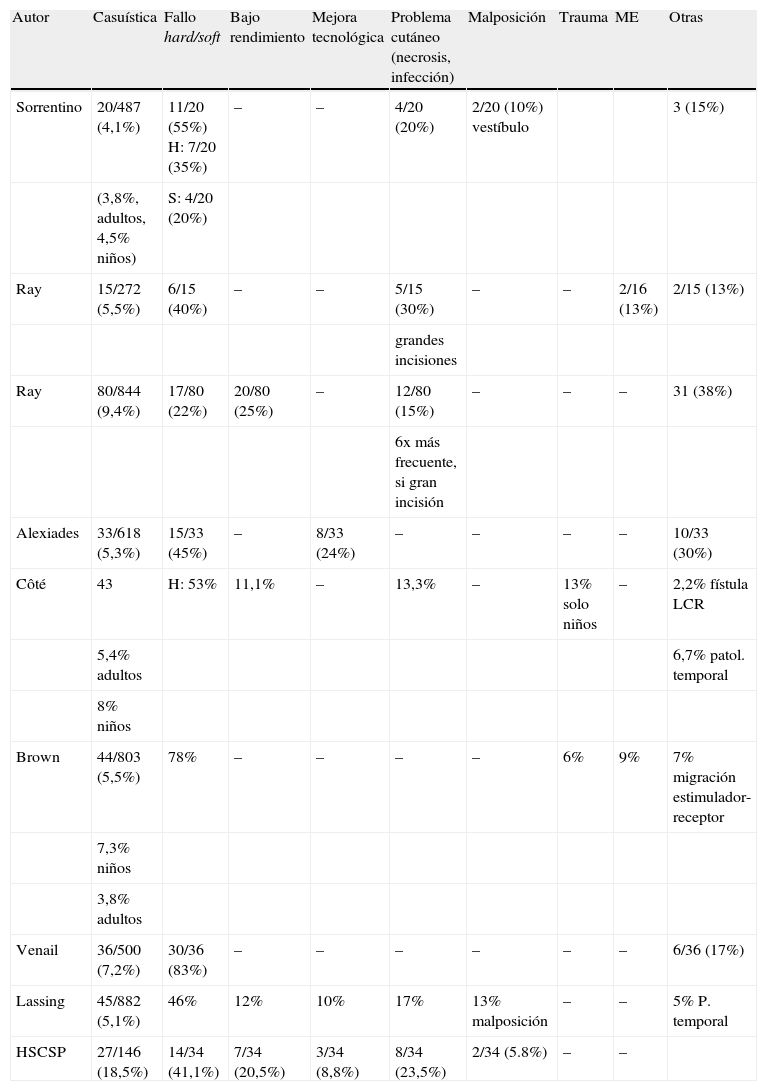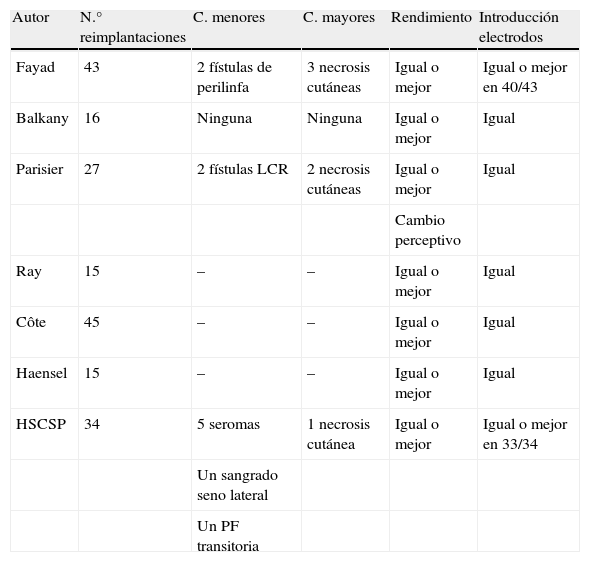Los implantes cocleares son, por diversos motivos, dispositivos electrónicos perecederos y, en ocasiones, han de reemplazarse. La técnica quirúrgica de reimplantación coclear, si bien no difiere substancialmente de la implantación virgen, si tiene unas peculiaridades características. En este artículo se analizan estas peculiaridades, no solo desde el punto de vista técnico, si no también respecto a las complicaciones que genera y el rendimiento funcional auditivo que consigue.
ObjetivosDescripción detallada de los hallazgos operatorios, las peculiaridades de la técnica quirúrgica y las complicaciones generadas en el proceso de reimplantación coclear. Evaluación del rendimiento auditivo funcional del paciente reimplantado.
Material y métodoRevisión descriptiva retrospectiva de 34 reimplantaciones en el mismo oído, realizadas en nuestro servicio durante el periodo entre 1993 y 2008 en 27 pacientes en un hospital terciario por el mismo equipo de cirujanos. Los implantes reemplazados fueron 2 Ineraid® (Smith & Nephew Richards), 23 Laura® (Philips Hearing Implants), 8 Nucleus 24K® (Cochlear Corp.) y un Clarion® (Advanced Bionics).
ResultadosLa tasa de reimplantación por paciente en el mismo oído fue del 18,5%. La causa más frecuente de reimplantación en nuestra serie fue el fallo interno del implante (14 casos). Otras causas fueron la substitución por actualización tecnológica (7 casos), malposición del haz de electrodos (8 casos), necrosis/infección del colgajo cutáneo con exposición del implante (3 casos) y por último traumatismos externos (2 casos). Los hallazgos operatorios más significativos fueron la reosificación parcial de la mastoidectomía, la ausencia de osificación de la timpanotomía posterior y la permeabilidad de la espira basal de la cóclea cuando esta alojaba el haz de electrodos. En 25 pacientes, se consiguió una reintroducción completa del haz de electrodos y en 2 pacientes una introducción parcial. La tasa de complicaciones generadas fueron, tanto cuantitativamente como cualitativamente, comparables a la tasa de implantación en el oído virgen, salvo cuando el implante original fue del tipo Ineraid®.
ConclusionesLa técnica quirúrgica de reimplantación y de multirreimplantación tiene peculiaridades específicas en cado uno de sus pasos, pero, en términos generales, tiene una complejidad parecida a la implantación de oídos vírgenes y se asocia a una tasa de complicaciones similar. La introducción del nuevo haz de electrodos es sencilla y completa en la inmensa mayoría de casos, dado que la cóclea permanece permeable, siempre y cuando aloje al haz de electrodos; en caso contrario, tiene tendencia a reosificarse. El rendimiento auditivo esperable del nuevo implante está en consonancia con sus prestaciones. Si son iguales a las del implante substituido, el rendimiento auditivo del implantado es similar, y si son mejores, también lo es su rendimiento, excepto en oídos con grandes periodos de deprivación auditiva.
Cochlear implants are, for many reasons, expirable electronic devices and occasionally may have to be replaced. The surgical cochlear reimplantation technique is not substantially different from the initial implantation but does have some peculiarities. These peculiarities are analyzed in this paper not only from the point of view of surgical technique but also with respect to the complications involved and the functional auditive outcome obtained.
ObjectivesAn accurate description of the surgical findings, peculiarities of the surgical technique and complications found during the process of cochlear reimplantation. An evaluation of the audiometric functional outcome of the reimplantation.
Material and methodA descriptive retrospective review of 34 reimplantations in the same ear, carried out at our department during the period between 1993 and 2008, in 27 patients in a tertiary hospital by the same team of seniors surgeons. The cochlear implants replaced were 2 Ineraid ® (Smith & Nephew Richards, TN), 23 Laura ® (Philips Hearing Implants), 8 nucleus 24K ® (Cochlear Corp., Englewood, CO), 1 Clarion r (Advanced Bionics, Sylmar, CA).
ResultsThe rate of reimplantation in the same ear was 18.5% per patient. The most frequent reason in our series was internal failure of the device (14 cases). Other causes were substitution for a technological update (7 cases), misplacement of electrodes (8 cases), necrosis/infection of the skin flap with exposure of the implant (3 cases) and external injuries (2 cases). The most important surgical findings were partial mastoidectomy reossification, absence of ossification in the posterior tympanostomy and the permeability of the basal turn of the cochlea when it housed the electrodes. A complete reintroduction of the electrodes was achieved in 25 patients and a partial one in 2 patients. The rate of complications generated was similar in reimplantation and in virgin ear implantation, except for when the original implant was an Ineraid device.
ConclusionsThe surgical technique of reimplantation and multireimplantation technique has characteristic peculiarities at each step, but in general terms, its complexity is similar to that of implantation in virgin ears and the rate of complications is also similar. The introduction of the new electrodes is simple and complete in the immense majority of cases, given that the cochlea remains permeable, as long as it houses the electrodes; otherwise it tends to become reossified. The functional auditory outcome of the new implant is in relation with its capacities. If they are equal to those of the initial implant then the auditory outcome will be similar and if they are better, then so will the outcome be, with the exception of ears with long periods of auditive deprivation.
Artículo
Comprando el artículo el PDF del mismo podrá ser descargado
Precio 19,34 €
Comprar ahora











